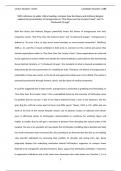Lecture notes
English Literature Coursework Example - FULL MARKS
NEA English Literature Coursework discussing the question 'With reference to wider critical reading, compare how Ken Kesey and Anthony Burgess explore the presentation of transgression in “One Flew over the Cuckoo’s Nest” and “A Clockwork Orange”'. Achieved 60/60 FULL MARKS. Useful for th...
[Show more]



